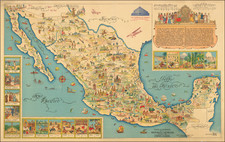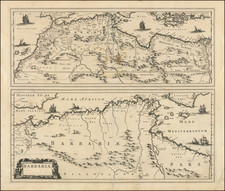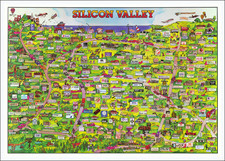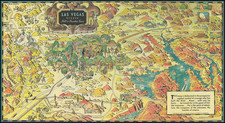This striking mid-20th-century pictorial map by Lucien Boucher, titled "Crédit Lyonnais Fondé En 1863 Afrique du Nord Union Française," showcases the former French colonies in Africa, highlighting their diverse industries and resources, in the context of promoting the French credit company Crédit Lyonnais.
Created circa 1945, the map captures the spirit of the post-World War II era, as France sought to reestablish its economic influence in its African colonies. The richly detailed illustration not only reflects France's colonial history but also emphasizes the economic potential of these territories. The map artistically represents various industries, from gold mining to goat rearing, indicating the range of resources and opportunities found in these regions.
The talented Lucien Boucher, a French artist known for his work with Air France and his decorative cartography, masterfully created this captivating piece. His distinctive style and attention to detail are evident throughout the map, giving it both artistic and historical value. Printed by Perceval Paris, a renowned printing house, the map's vivid colors and high-quality production techniques further enhance its visual appeal.
As a snapshot of France's post-war colonial aspirations and a showcase of its economic interests in Africa, this pictorial map offers valuable insights into the historical context of the period. It also stands as a testament to the enduring appeal of Lucien Boucher's cartographic artistry.
Lucien Boucher (1889-1971) was a French artist whose work spanned various mediums including cartooning, painting, and illustration. Born in Chartres and educated at the École de Céramique de Sèvres, Boucher initially focused on ceramics before World War I significantly altered his artistic trajectory. His period of captivity as a prisoner of war during the conflict led him to discover and hone his skills in drawing, thereby shaping his future career.
Before the war, Boucher had already begun to make a name for himself in the French art scene, particularly through his cartoons published in the weekly magazine "Le Rire." His early works demonstrated his capability for visual satire, but his subsequent experience in the war led to a more serious engagement with themes and subjects. After his return, Boucher navigated toward commercial illustration and poster design, successfully integrating his artistic sensibilities with the needs of the market.
Starting in the 1920s, Boucher began to produce a series of posters that drew inspiration from the surrealism movement. This work culminated in his most well-known project: a series of planispheric and celestial maps designed for Air France. These maps served a dual purpose. While they were essentially utilitarian, providing navigational information, they were also aesthetically innovative. Boucher employed elements of surrealism to add layers of meaning, transforming what could have been straightforward maps into more complex visual narratives.
Boucher's work with Air France solidified his reputation as an artist who could balance commercial needs with artistic innovation. His approach to map-making was characterized by a careful attention to detail, a strong sense of composition, and a willingness to explore the boundaries of the medium. While his maps were intended to serve a practical function, they also succeeded in capturing the public's imagination, offering a vision of travel that was aspirational yet grounded in geographical realities.











![[Hand-Drawn Map Showing the Extent of the Ottoman Empire]](https://storage.googleapis.com/raremaps/img/small/99654.jpg)


![Carte generale de l'Empire romain [des Sarrasins]](https://storage.googleapis.com/raremaps/img/small/82000.jpg)

